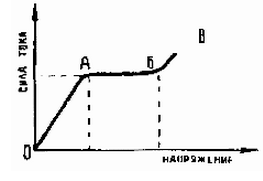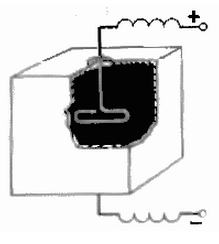
|
|
ENCYCLOPEDIA OF RADIO ELECTRONICS AND ELECTRICAL ENGINEERING radioactive radiation. How to detect it? Encyclopedia of radio electronics and electrical engineering
Encyclopedia of radio electronics and electrical engineering / Dosimeters Special devices help detect radioactive contamination in time. Of course, we are not able to see, hear or "catch" a radioactive particle. But the devices use the properties of radioactive radiation - to give different effects when passing through a substance. For example, under the influence of radioactive radiation, some substances begin to glow, a number of solutions change their color, and photographic plates are illuminated. The most common method for detecting radioactive emissions is by their ability to ionize various gases. You can assemble the simplest device for this yourself (Fig. 1). Place two metal plates in a plastic box or glass vessel and apply voltage to them from a DC source or rectifier. Connect the measuring device to the circuit. Take a rectifier that would allow you to change the voltage from 0 to 400 V.
As long as there are no ions in the air, the air is an insulator, the circuit is open and no current flows through it. If, under the influence of radioactive radiation, electrically charged ions appear between the plates, then they immediately begin to move - positive to the negative plate, negative - to the positive, that is, an electric current begins to flow between the plates. The amount of current depends on two reasons: on the strength of the radioactive radiation and on the voltage that we apply to the plates. If, with the same radioactive radiation, we gradually increase the voltage on the plates, and then put the microammeter reading on the graph, we get the picture shown in Figure 2.
We noticed that in the section OA, the current strength increases proportionally plate stress? This is because the lifetime of the ion is very short and at low voltages, some of the ions do not have time to "run" to the plates - they meet with ions of the opposite sign, combine with them (recombine) and turn into neutral atoms. The higher the voltage, the more ions have time to "run" to the plates and, therefore, the stronger the current. In the AB section, the voltage increases, but the current does not increase. What is the riddle? It is simple - all the ions that were formed from radioactive radiation managed to "run" to the plates, and there are simply no other ions. This current is called the saturation current, and the area on the graph is called the "PLATO" area. In the BV section, the voltage increases slightly, and the current increases sharply. The voltage here crosses the boundary beyond which the gas discharge begins. In a gas discharge, the energy that an ion gains when moving towards the plate immediately becomes so great that this ion, falling into a neighboring atom, breaks it into 2 ions. Those, in turn, break the next two atoms, etc. Thus, it is enough to appear between the plates at least one pair of ions, as the instantaneous ionization of the entire gas between the plates occurs. Of course, the sensors (or, as they say, detectors) that are used in dosimetric instruments are different from our primitive plates. To detect large doses of radioactive radiation, devices with ionization chambers are used. What does she represent? It is an air-filled plastic box with walls coated with graphite. A T-shaped electrode is fixed inside the box (Fig. 3), and the walls serve as a second electrode.
Ionization chambers operate in the "plateau" voltage region (Fig. 2). Therefore, as you probably guessed, the ionization current strongly depends on the volume of the chamber - the larger the chamber, the more ions it contains. For accurate measurements, devices with gas-discharge counters are used. Each counter has a positive electrode - the central thread - and a cylindrical negative electrode surrounding it (Fig. 4). The central thread is made of a special alloy - kovara. Cylindrical electrode - made of steel with a thickness of about 50 microns or glass with a copper layer deposited on its surface.
The counters are filled with a neon-argon mixture with the addition of halogens (chlorine, bromine) or alcohol. Halogens and highly atomic alcohols absorb gamma quanta well and therefore prevent the appearance of false discharges of the counter due to secondary electrons knocked out by gamma quanta from the walls of the counter. Such counters are also called self-extinguishing. The counters have a count rate, "dead time" and a gas amplification factor. The count rate is the number of flashes (pulses) per second. Self-extinguishing counters can give up to 5 thousand flashes (discharges) per second. "Dead time" is the time during which positive and negative ions "run" to their electrodes. At this time, any new particle that enters the counter will not be registered, since all the gas in the volume of the counter is already ionized. The gas amplification factor is a number showing how many times the primary number of ions is amplified as a result of avalanche ionization in the counter. It can reach tens of thousands. The industry produces a wide variety of meters; for example, STS-2, STS-5 (steel, self-extinguishing), type AS and STS, end - MST-17, insensitive - SI-BG, etc. The currents generated in ionization chambers and gas-discharge counters are so small that it is very difficult to measure them directly. You have to pre-amplify. The most commonly used tube amplifier. To measure in this case, the voltage from the high-resistance is applied to the control grid of the triode lamp (Fig. 5). The negative voltage on the grid is selected so that in the absence of current through the gas-discharge counter, the lamp is locked. If current flows in the meter circuit, then the voltage on the lamp grid will decrease to such a value that the lamp “opens” and current flows through it. The more current will flow in the meter circuit, the more current will flow through the lamp, in its anode circuit. But the current in the anode circuit is many times greater than the current in the meter circuit. This means that it can already be measured with a conventional microammeter.
Usually, several high-resistance resistors of different sizes are included in the circuit. Then the measuring range expands. In this way, only the total currents from a plurality of discharges in a gas-discharge counter are measured. If you need to accurately calculate the number of flashes in it, then mechanical counters and electronic counters are used. The counting rate of a gas-discharge counter, as already mentioned, is about 5 thousand pulses per second, and a mechanical one is only 100 pulses per second. Therefore, to increase the resolution of a mechanical counter, scaling schemes are used. You can read about the device and the principle of their operation on counting cells (triggers) in the book by I. P. Bondarenko and N. V. Bondarenko "Fundamentals of dosimetry of ionizing radiation" (ed. "Higher school", M., 1962). To measure radiation doses received over a certain time, two methods are mainly used: 1) measuring the degree of discharge of a capacitor charged to a certain potential, and 2) changing the color of some solutions under the influence of ionizing radiation. Devices for measuring the received doses are called dosimeters. An individual dosimeter is a capacitor, one electrode of which is the central pin, and the second is the body. In order to find out what dose of radiation has passed through the device, the initial and residual charges of the dosimeter are measured with a special device. A chemical dosimeter is an ampoule filled with a specific solution. Under the influence of radiation, the color of the solution changes. The simplest dosimeter can be a conventional laboratory electroscope, the scale of which is pre-calibrated in roentgens or milliroentgens. Being charged, such an electroscope, under the influence of ionizing radiation, will begin to discharge. By the magnitude of its discharge, one can judge the radiation dose. Authors: A.Tsurikov, O.Kalinichenko
Artificial leather for touch emulation
15.04.2024 Petgugu Global cat litter
15.04.2024 The attractiveness of caring men
14.04.2024
▪ Teleportation of solar energy ▪ Overweight people are happier ▪ Space hotel rooms available for booking
▪ site section Electric meters. Article selection ▪ article I did what I could, let those who can do better. Popular expression ▪ Article Head of Public Relations Department. Job description ▪ article Lollipops. Simple recipes and tips ▪ article Three cards move from one part of the deck to another. Focus secret
Home page | Library | Articles | Website map | Site Reviews www.diagram.com.ua |






 Arabic
Arabic Bengali
Bengali Chinese
Chinese English
English French
French German
German Hebrew
Hebrew Hindi
Hindi Italian
Italian Japanese
Japanese Korean
Korean Malay
Malay Polish
Polish Portuguese
Portuguese Spanish
Spanish Turkish
Turkish Ukrainian
Ukrainian Vietnamese
Vietnamese





 Leave your comment on this article:
Leave your comment on this article: